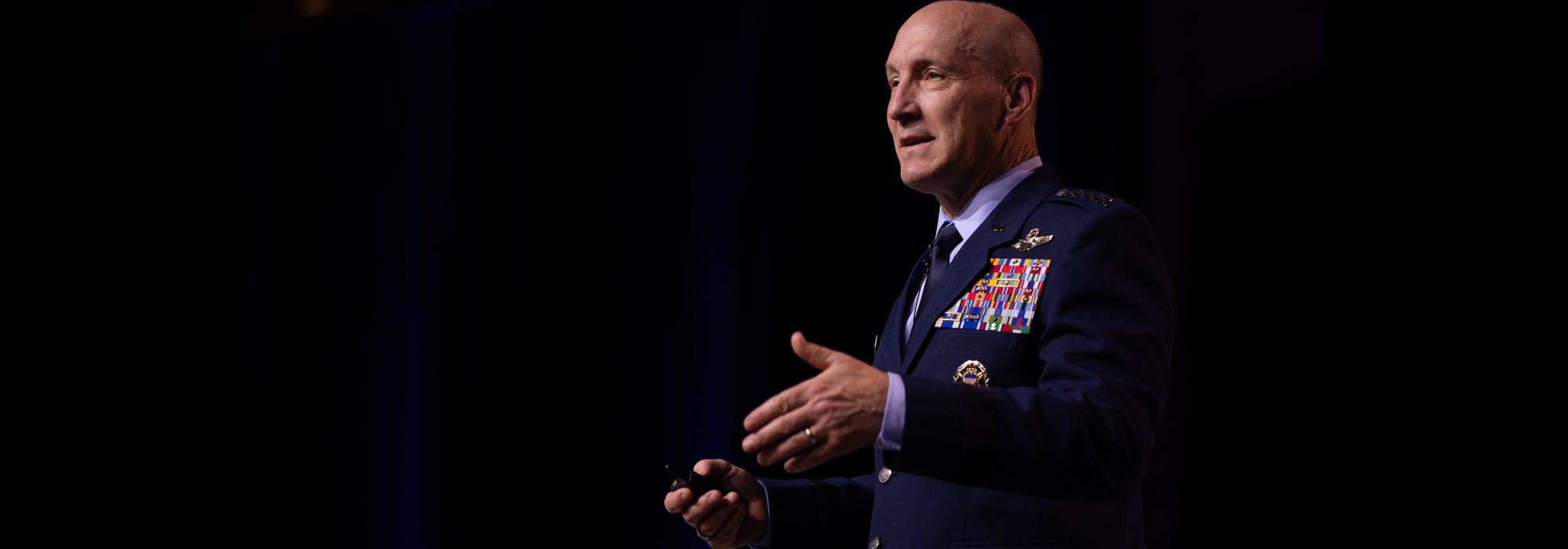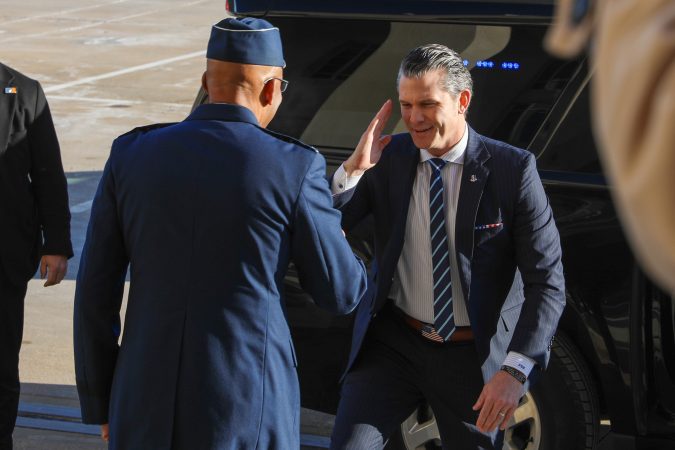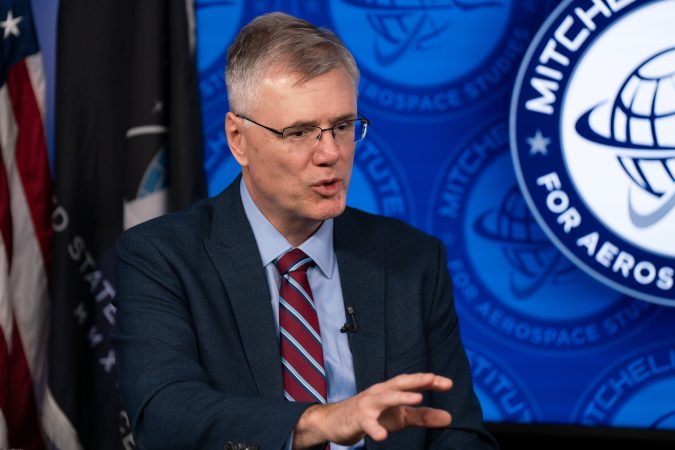More Air Force, a Missile Shield, and the Pentagon’s New Boss
Allvin says today’s Air Force is too small. Can he convince Hegseth?
By A&SF Magazine Staff
A year into his role as Air Force Chief of Staff, Gen. David W. Allvin is acknowledging something Air Force critics have been saying for years: “We need more Air Force.”
The Chief first voiced that concern in November at the Mitchell Institute’s Airpower Futures Forum and followed up with a January essay on BreakingDefense.com: “America needs more Air Force and it needs it now,” he wrote. “Today, our aircraft fleet is smaller and older than any time in history, and the gap between our high-end combat training and that of our pacing competitors has closed dramatically. … It is my assessment this risk is unacceptable and will continue to rise without substantially increased investment in airpower.”
Allvin’s plea comes as a new administration takes over in Washington, D.C., bringing with it new priorities and perspectives at the Pentagon. New Secretary of Defense Pete Hegseth and prospective Secretary of the Air Force Dr. Troy E. Meink, who was awaiting confirmation at press time, will have some chance to tinker with the fiscal 2026 budget before sending it to Congress in March or April—but the President seems intent on more than tinkering. The White House pumped dozens of executive orders out and policy memos following President Donald Trump’s inauguration Jan. 20, covering everything from the border crisis to diversity, equity, and inclusion (DEI) and a space-based missile defense system.
Even before Hegseth was confirmed, the Pentagon ordered a shutdown of DEI offices and programs. Then came aftershocks: Air Education and Training Command identified and suspended use of a three-hour block in the Basic Military Training curriculum that had “DEI material,” prompting news stories saying the Tuskegee Airmen and Women Air Force Service Pilots (WASPs) were no longer being remembered at BMT. That, in turn, led Trump supporters to claim the Air Force cut the videos intentionally to spark outrage, calling the action “malicious compliance.”
The truth was more benign, Allvin said in a statement. “No curriculum or content highlighting the honor and valor of the Tuskegee Airmen or Women Air Force Service Pilots has been removed from Basic Military Training.”
The episode highlighted the challenges Allvin and other military leaders face as they implement the new administration’s policies while at the same time executing existing plans and programs.
Allvin is at once making the case that his Air Force is too small and underfunded; that a new Force Design is needed to ensure a ready force in the future; and that readiness today demands a more disciplined force that adheres to a higher, stiffer set of standards than what became the norm in recent years.
New Boss
At the Pentagon, where Lloyd Austin III was Secretary for the past four years, Hegseth arrived Jan. 27 representing a new generation of leadership. Austin was a retired Army four-star general; Hegseth, a former Army major, is decades younger.
Met at his car by Chairman of the Joint Chiefs of Staff Gen. Charles Q. Brown Jr., Hegseth was all smiles as he and his Chairman entered the building that Monday morning. The meeting had the potential for awkwardness; Hegseth has said in the past that Brown “should be fired,” but when reporters asked if that was in the cards, he waved the questions away.
“Talking to the Chairman, and so many other folks here, we’re in capable hands,” he said. “The warfighters are ready to go.”
What he thinks about their equipment is still to come. While Hegseth’s confirmation hearing focused largely on questions about his past personal behavior, he did indicate concerns about China and readiness, as well as an eagerness to “look under the hood” at Air Force programs. And while he declared his Day One priority to be securing the border, he also said a long-term priority would be China.
He and the White House touted plans for a missile shield to protect the U.S. homeland. Trump made the issue a part of his 2024 campaign platform, pledging to “invest in cutting-edge research and advanced technologies, including an Iron Dome Missile Defense Shield.”
A White House Executive Order called for a 60-day review of America’s missile defense capabilities with an “implementation plan for the next-generation missile defense shield.” That might be the system the Space Development Agency has under development, or a combination of systems operating in different orbital regimes. The President wants increased emphasis on space-based missile tracking capabilities operated by the Space Force, as well as next-generation missile interceptors and space-based weapons.
“The architecture shall include, at a minimum, plans … against ballistic, hypersonic, advanced cruise missiles, and other next-generation aerial attacks from peer, near-peer, and rogue adversaries,” the order states.
Hegseth has said his long-term national security focus is China—the top threat identified by the Biden administration and the first Trump administration.
“We will reestablish deterrence by defending our homeland—on the ground and in the sky,” Hegseth said in his first message to the force Jan. 25. “We will work with allies and partners to deter aggression in the Indo-Pacific by Communist China, as well as supporting the President’s priority to end wars responsibly and reorient to key threats.”
Growing USAF Airpower
Allvin’s plea for more Air Force is driven by those same concerns about China coupled with “accumulating risk” taken by Air Force leaders over the past decades as the Air Force gave up investment in modernization, training, and readiness to cover short-term financial needs.
“The aggregate effect is the eroding advantage of American airpower,” Allvin said. “It’s past time to stop that erosion.”
What he intends to pursue is not“more expensive ‘stuff,’” he said, but rather a new “mix of exquisite and low-cost capabilities to provide dilemmas for adversaries and stay on the right side of the cost curve.”
Among the decisions the new administration faces are:
What to do about the Next-Generation Air Dominance penetrating aircraft, a manned fighter that would cost hundreds of millions of dollars each;
How fast the Air Force can develop semi-autonomous Collaborative Combat Aircraft that would complement high-end fighters;
How to deliver more Air Force and reverse the erosion it’s suffered while, at the same time, expanding the Space Force to meet its growing requirements.
“We cannot reduce personnel,” Allvin said. High operational tempo, demands for efficiency, the effects of sequestration and personnel costs that outpaced inflation “left us with a force already 20,000 to 30,000 Airmen short of our requirements,” he said, and mission readiness “has become the most ‘convenient’ [account to rob] … because the cuts can be broken into smaller pieces, more digestible in the moment with fewer immediate political consequences.”
The risk is a hollow force, he said. “We’ve been there and should never go back . … We must be allowed to grow.”
Trump Picks NRO’s Meink as SECAF
By Chris Gordon
President Donald Trump’s choice to become the next Secretary of the Air Force is Troy E. Meink, an Air Force veteran whose follow-on civilian career has took him to the National Reconnaissance Office, where he’s been the principal deputy director for the past five years.
If confirmed, Meink would be the first Air Force Secretary to come to the job from the NRO in decades—Hans Mark served concurrently as undersecretary of the Air Force and head of the NRO before becoming Air Force Secretary in 1979 and John L. McLucas served as the fourth director of the NRO before becoming Air Force Secretary in 1973.
Since then, other Air Force secretaries have had some background in space—Barbara Barrett and Edward Aldridge were both trained for space flight, Michael Wynne and John J. Welch Jr. both oversaw space divisions within the defense industry, and Robert Seamans and Mark were both deputy NASA administrators.
But Meink would be unique given how deep his experience is at the intersection of defense and space. While he served in the Air Force as a KC-135 tanker navigator from 1988 to 1993, he spent much of his career as a civilian working for the Air Force in various space roles, including as the deputy undersecretary of the Air Force for space. He has been at the NRO for years, having been appointed to his current role under the previous Trump administration.
Before becoming the NRO’s current No. 2 in 2020, Meink was the director of Geospatial Intelligence Systems Acquisition (GEOINT) at the agency and responsible for a $15 billion budget overseeing acquiring satellite systems.
Meink’s selection may be a significant boost for the Space Force—USSF leaders have said their service needs more resources and manpower to keep up with a growing mission set, as they face their first-ever budget cut in 2025. Trump is seen as friendly to the Space Force, having championed its creation in his first term, and Meink would be perhaps the most space-knowledgeable senior leader in the Pentagon.
Meink would likely step on the other side of an ongoing debate between the Space Force and the NRO and other Intelligence Community agencies over roles and responsibilities for intelligence, surveillance, and reconnaissance from space.
Beyond that, however, Meink will face major questions during the confirmation process and early in his tenure about how to handle the Air Force’s Next-Generation Air Dominance program, Collaborative Combat Aircraft drones, and the over-budget and behind-schedule Sentinel intercontinental ballistic missile.
The Department of the Air Force pick had been a notable hole in Trump’s planned national security team.
Pete Hegseth, a former Fox News host and Army National Guard officer, was confirmed as Trump’s pick to be the 29th Secretary of Defense on Jan. 27, despite allegations of personal misconduct and intense criticism from Democrats.
“Troy will work with our incredible Secretary of Defense … Pete Hegseth, to ensure that our Nation’s Air Force is the most effective and deadly force in the world, as we secure PEACE THROUGH STRENGTH,” Trump wrote in a post on his social media network Truth Social.
Meink would round out Trump’s picks for service secretaries. Trump named John Phelan, a businessman donor with an MBA from Harvard, to be Secretary of the Navy and Daniel P. Driscoll, an Army veteran and Yale Law School graduate, to lead the Army. Driscoll has been a senior adviser to fellow Yale Law grad Vice President J.D. Vance.
Stephen Feinberg, financier, is Trump’s pick for deputy Secretary of Defense, and Elbridge “Bridge” Colby has been named to lead the Pentagon’s policy shop.
News Editor Greg Hadley contributed to this report.


